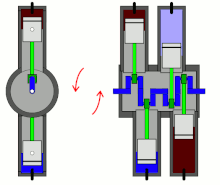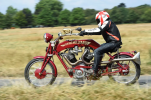Posting this to help someone who may be inexperienced with engines; is wide-eyed about the information on their website; is not deterred by the owner's sketchy past; is on the fence; is looking for an opinion from someone experienced with conversions and modern fuel injected engines; and who desires an objective analysis using readily available evidence. In this endeavor, I apologize for the length of this post. The main and perhaps only advantage I see is that if someone is dead set on this conversion, all the hard work has been done. Most of the conversion parts such as fuel systems/ tuning, engine mount, and gear box, etc are already fabricated and tested. This is huge and I have to give a lot of recognition for the amount of work and testing and attention to detail that went into this conversion. This is no small feat and is nothing short of an impressive demonstration by dedicated craftsmen. Much of the experimenting appears to have been performed by customers willing to participate in experimental aviation for the joy of it, and joining these ranks must irrevocably be considered as a part of the decision-making process. The 130 hp engine you receive for $14k will be complete, ready to run, and has the advertised power. Unfortunately, this is where any advantages seem to end. This is impressive for that price until you delve a bit deeper. In order to create a marketable and profitable product, price, power, and weight parameters must be optimized. While the weight is unimpressive and can be considered a disadvantage, the inherent marine-service design plus custom engine tuning make this aircraft conversion appear worthy. Without the tuning, power to weight crosses the red line, as the power provided for the engine weight is not acceptable. This is where things get a bit sketchy. The engine provided is a used automotive salvage engine factory-rated at about 95 hp. Even the most powerful marine version of this engine is rated at 100 hp. As mentioned, tuning is utilized to squeeze the extra juice to make power to weight more palatable. While the 30%-plus tuned power gain over the factory rating seems impressive, it is also concerning as there is no testing or evidence outside of customer experimentation demonstrating these engines can be reliably run with this much power. Certainly, Honda engineers did not design this engine to make this much power and are not crawling over themselves to claim it can safely do so. Therefore, the margin for risk of mechanical failure is thinner and the customer must be comfortable within the realm of experimentation. This power/displacement information is available from Honda Motors and Honda Marine. This begs the question of sound investment via reconciliation of: 1) reliability from a used auto engine, 2) the price paid for it, and 3) the warranty provided. Reliability is self-evident, as most auto junkyards give at most 30 days. Even though this is experimental aviation, the gorilla in the room is a highly-tuned junkyard auto engine enduring power demands well beyond its engineered design capability. In addition, it behooves one-self to consider that many would not feel comfortable driving in their car through the bad part of town with such a used engine. From what I can gather there is effectively no warranty unless the owner of the company will freely admit fault, and I can find no evidence of that any more than I can find high-hour examples of their engines. What I have found without difficulty are examples of aircraft on their second or third engine. Clearly, it would not be outside of normal expectation to see the actual cost of the engine easily become the cost of two or three engines, etc to meet the nominal expected TBO of an actual aviation engine. Considering this, certainly any minute price advantage vaporizes. Beyond having no concrete price savings, if one is stubborn enough to require further demonstration of reliability differences then look no further than the "48 state challenge", which is nothing more than about 100 hours of tachometer time in a matter of about 10 days. This is normal-duty for a flight-school Cessna, which may see 100-hour inspections 2-3 times per month. Imagine how ridiculous it would appear if any other aircraft engine company used this challenge to demonstrate reliability, which should in competitive terms be in the thousands of hours of tachometer time for this investment, not in the tens or even hundreds of hours. So, is there anything here left to salvage? No pun intended. Well, that brings us full circle, back to the Honda Marine virtues of the engine. Along with the conversion parts being sold, a new marine engine may be worth consideration, especially with the price of an entire brand-new Honda BF100 outboard hovering around $10k. Not many would argue that a brand-new marine engine actually marketed for continuous high-output duty is not better than an automotive salvage engine. I dont know if anyone has done this, if its worth doing, if it will be more reliable, or if it will even work, but is there anything here left to salvage besides experimentation? Conclusively, experimentation must be the goal of the endeavor itself, as better options certainly exist. However, that is exactly where we started.



